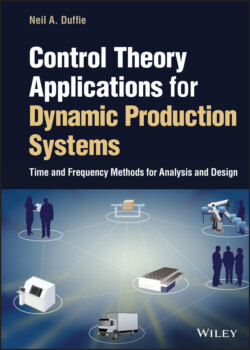Читать книгу Control Theory Applications for Dynamic Production Systems - Neil A. Duffie - Страница 5
Contents
Оглавление1 Cover
5 Preface
7 1 Introduction1.1 Control System Engineering Software
8 2 Continuous-Time and Discrete-Time Modeling of Production Systems2.1 Continuous-Time Models of Components of Production Systems2.2 Discrete-Time Models of Components of Production Systems2.3 Delay2.4 Model Linearization2.4.1 Linearization Using Taylor Series Expansion – One Independent Variable2.4.2 Linearization Using Taylor Series Expansion – Multiple Independent Variables2.4.3 Piecewise Approximation2.5 Summary
9 3 Transfer Functions and Block Diagrams3.1 Laplace Transform3.2 Properties of the Laplace Transform3.2.1 Laplace Transform of a Function of Time Multiplied by a Constant3.2.2 Laplace Transform of the Sum of Two Functions of Time3.2.3 Laplace Transform of the First Derivative of a Function of Time3.2.4 Laplace Transform of Higher Derivatives of a Function of Time Function3.2.5 Laplace Transform of Function with Time Delay3.3 Continuous-Time Transfer Functions3.4 Z Transform3.5 Properties of the Z Transform3.5.1 Z Transform of a Sequence Multiplied by a Constant3.5.2 Z Transform of the Sum of Two Sequences3.5.3 Z Transform of Time Delay dT3.5.4 Z Transform of a Difference Equation3.6 Discrete-Time Transfer Functions3.7 Block Diagrams3.8 Transfer Function Algebra3.8.1 Series Relationships3.8.2 Parallel Relationships3.8.3 Closed-Loop Relationships3.8.4 Transfer Functions of Production Systems with Multiple Inputs and Outputs3.8.5 Matrices of Transfer Functions3.8.6 Factors of Transfer Function Numerator and Denominator3.8.7 Canceling Common Factors in a Transfer Function3.8.8 Padé Approximation of Continuous-Time Delay3.8.9 Absorption of Discrete Time Delay3.9 Production Systems with Continuous-Time and Discrete-Time Components3.9.1 Transfer Function of a Zero-Order Hold (ZOH)3.9.2 Discrete-Time Transfer Function Representing Continuous-Time Components Preceded by a Hold and Followed by a Sampler3.10 Potential Problems in Numerical Computations Using Transfer Functions3.11 Summary
10 4 Fundamental Dynamic Characteristics and Time Response4.1 Obtaining Fundamental Dynamic Characteristics from Transfer Functions4.1.1 Characteristic Equation4.1.2 Fundamental Continuous-Time Dynamic Characteristics4.1.3 Continuous-Time Stability Criterion4.1.4 Fundamental Discrete-Time Dynamic Characteristics4.1.5 Discrete-Time Stability Criterion4.2 Characteristics of Time Response4.2.1 Calculation of Time Response4.2.2 Step Response Characteristics4.3 Summary
11 5 Frequency Response5.1 Frequency Response of Continuous-Time Systems5.1.1 Frequency Response of Integrating Continuous-Time Production Systems or Components5.1.2 Frequency Response of 1st-order Continuous-Time Production Systems or Components5.1.3 Frequency Response of 2nd-order Continuous-Time Production Systems or Components5.1.4 Frequency Response of Delay in Continuous-Time Production Systems or Components5.2 Frequency Response of Discrete-Time Systems5.2.1 Frequency Response of Discrete-Time Integrating Production Systems or Components5.2.2 Frequency Response of Discrete-Time 1st-Order Production Systems or Components5.2.3 Aliasing Errors5.3 Frequency Response Characteristics5.3.1 Zero-Frequency Magnitude (DC Gain) and Bandwidth5.3.2 Magnitude (Gain) Margin and Phase Margin5.4 Summary
12 6 Design of Decision-Making for Closed-Loop Production Systems6.1 Basic Types of Continuous-Time Control6.1.1 Continuous-Time Proportional Control6.1.2 Continuous-Time Proportional Plus Derivative Control6.1.3 Continuous-Time Integral Control6.1.4 Continuous-Time Proportional Plus Integral Control6.2 Basic Types of Discrete-Time Control6.2.1 Discrete-Time Proportional Control6.2.2 Discrete-Time Proportional Plus Derivative Control6.2.3 Discrete-Time Integral Control6.2.4 Discrete-Time Proportional Plus Integral Control6.3 Control Design Using Time Response6.4 Direct Design of Decision-Making6.4.1 Model Simplification by Eliminating Small Time Constants and Delays6.5 Design Using Frequency Response6.5.1 Using the Frequency Response Guidelines to Design Decision-Making6.6 Closed-Loop Decision-Making Topologies6.6.1 PID Control6.6.2 Decision-Making Components in the Feedback Path6.6.3 Cascade Control6.6.4 Feedforward Control6.6.5 Circumventing Time Delay Using a Smith Predictor Topology6.7 Sensitivity to Parameter Variations6.8 Summary
13 7 Application Examples7.1 Potential Impact of Digitalization on Improving Recovery Time in Replanning by Reducing Delays7.2 Adjustment of Steel Coil Deliveries in a Production Network with Inventory Information Sharing7.3 Effect of Order Flow Information Sharing on the Dynamic Behavior of a Production Network7.4 Adjustment of Cross-Trained and Permanent Worker Capacity7.5 Closed-Loop, Multi-Rate Production System with Different Adjustment Periods for WIP and Backlog Regulation7.6 SummaryReferences
14 Bibliography
15 Index
